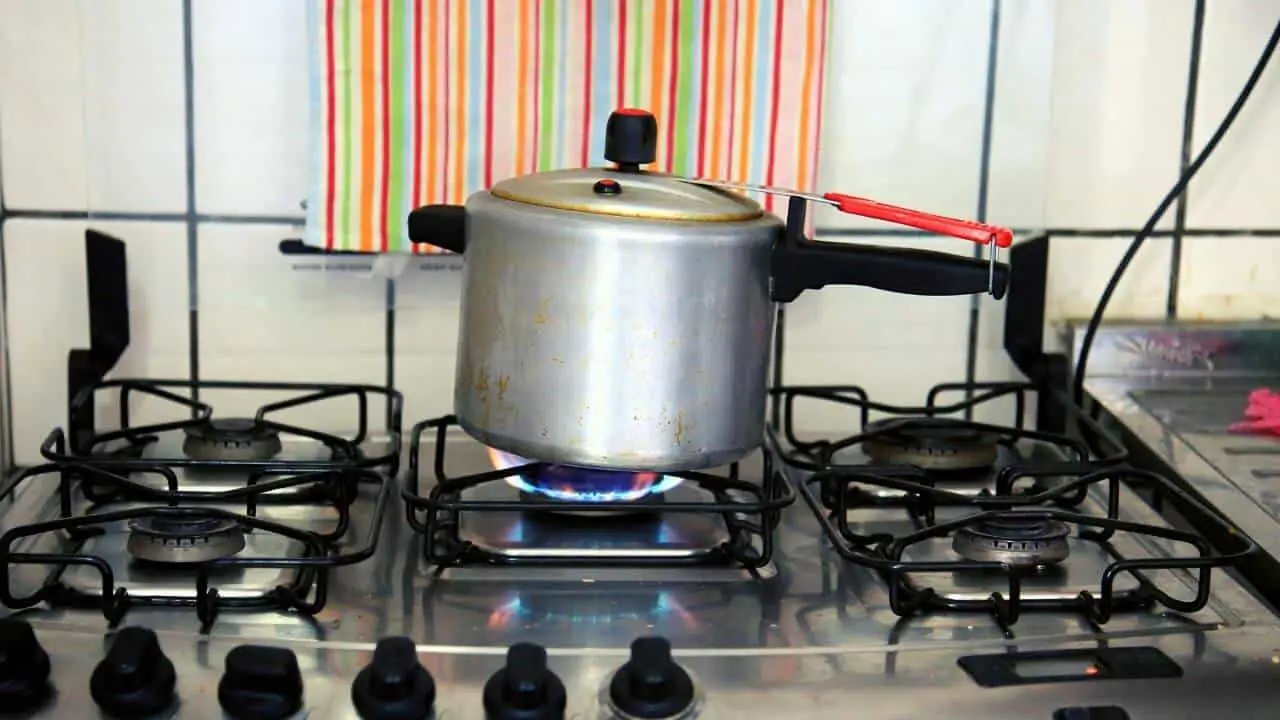Last Updated on May 19, 2023 by River Tree Farms
The last thing you want to worry about is getting a burn Message from your pressure cooker! It happens when you use an electric pressure cooker, and it burns on the bottom.
One of the biggest questions for users is regarding burn notices. They ask how to stop the pressure cooker from burning on the bottom. Your food burns on the bottom due to extreme heat. Maintaining proper temperature can solve it.
But there are other reasons for food burning in pressure cookers. Please keep reading to learn more about it.
Why Do Pressure Cookers Burn on the Bottom?
You may have noticed that your pressure cooker burns the bottom. There are many possible reasons. Modern pressure cookers are designed to spread heat evenly. However, they still present some risk of burning your food. The common reasons for your pressure cooker burn on the bottom might be:
- Stuck food debris on the bottom
- Pressure cooking process
- Heat Level
- Excess Internal Pressure
- Food Placement on Heating element
- Faulty Pressure valve and Venting Position
Aside from those, you also cannot stir food while it cooks. Even when you have enough cooking liquid, your food could stick to the bottom of the cooker. With other cooking options, you get to stir food and prevent it from sticking to the bottom as it cooks. And there are some foods which burn easily too.
Do Some Foods Burn More Easily than Others?
Any food that you cook in a pressure cooker can burn. However, cream and milk are likely to burn faster than other foods. Starchy foods like rice, beans, and other foods burn fast as well. Soups with high starch and thickening agents also burn pretty fast. Tomato sauce, cream-based sauce, alfredo Sauce, etc are prone to burn.
10 Tips on How to Prevent Pressure Cookers From Burning on Bottom
Burning the bottom of your pressure cooker can be annoying. But it isn’t a hopeless situation. There are ways to cook your food evenly without burning it. Here are a few helpful tips:
1. Read the User Manual
Always go through the user manual before using your pressure cooker. It may provide guidelines for cooking food and keeping your cooker clean. There may be recommendations such as adjusting the heat, cooking times, and more.
Reading the entire manual may seem like a lengthy process. But it improves your experience. Even with electric pressure cookers with burn notices! Because the cook times depend on size, material, and brand. Failure to read the manual thoroughly is setting yourself up for disappointment.
2. Check the Rubber Sealing Ring
Check and ensure that the lid is positioned before pressure cooking. The rubber sealing ring on the lead should be functioning well. Once all your ingredients are in the cooker, close the lid well.
Ensure that the silicone sealing is in perfect condition. The lid must be in complete seal with the silicone seal. If it isn’t, you’ll constantly have steam coming out. The food at the bottom of your pot will burn.
3. Sufficient Liquid In the Pot
When there is enough liquid in your pressure cooker, it produces steam. The steam creates pressure to cook your food fast. Insufficient liquid, however, results in overheating errors.
So to stop the food at the bottom from burning, use plenty of liquid.
4. Use a Cooking Rack
Consider using a cooking rack at the base of your pressure cooker. It is ideal for vegetables and meats. Your food will cook evenly without burning.
The steam rack will prevent from food being directly over the heating element. By keeping your food off the bottom of the pot, you get to preserve nutrients and cook it perfectly.
5. Use Your Cooker as a Pressure Canner
Your pressure cooker can serve as a pressure canner. Especially when cooking cream-based jams, fruits, sauces, and jellies. Put a steam rack at the base of your pot, and then place the cans. The internal pressure will make sure the job is done. It is a simple tip to keep them from burning at the bottom.
6. Add Thickening Elements Later
Cornstarch, coconut milk, and flour are thickening elements. These can easily stick to the bottom of the cooking container. Therefore, you’d be wise to add them at the last stage of the cooking process.
7. Use a Non-Stick Pressure Cooker
Non-stick pressure cookers are not only easy to clean but also safe. They keep food from sticking to the bottom of the pan. Non-stick pressure cookers don’t always keep your food from burning. They do keep them from sticking to the bottom of your pan.
8. Use Low Heat
Burning is primarily caused by excess heat. So to keep your food from sticking to the bottom of the pan, use low heat. High heat is the biggest cause of most kitchen mishaps. It increases the likelihood of food sticking to the bottom of the pan. Using low heat will:
- Stop cooking liquid
- Cook well without burning
- Energy efficient
- Improve flavors and textures
9. Use a Pressure Cooker With a Thick Bottom
Stovetop Pressure cookers with thin bottoms can easily burn your food. When the bottom is too thin, heat doesn’t spread evenly. The bottom part receives more heat causing food burn.
With a thick bottom pan, heat is spread evenly. The chances of food sticking to the bottom are minimal.
10. Regular Maintenance
Maintenance issues can cause your pressure cooker to burn food. Problems do not always arise from the use error. If some parts are malfunctioning or defective, they need to be fixed as soon as possible. Also, cleaning the pot before pressure cooking is important too. To remove grease and food residue, you may use the following:
- Soapy water
- Dish soap
- Cleaning solution
Excellent seals are essential for the pressure cooker. It is to reach the high pressures and temperatures required. Malfunctioning safety valves may also affect the pressure in your cooker. Poor valves will burn your food and increase the risk of the cooker exploding.
So, before using your pressure cooker, always-
- Check all the critical components.
- Ensure that they are working well.
- Check the seal’s tightness.
How to detect that food is burning?
Cooking on the pressure cooker needs monitoring. So you should be aware of some signs of your food burning.
It can be a hissing or whistling sound from the pressure release valve. This can indicate that the food is boiling over and burning. Also, burning food has a strong and unpleasant odor. Smoke may also fill the kitchen. In short, you should look for:
- Smell
- Smoke
- Hissing or whistling sound
- Charring
- Sticking to the bottom
- The bitter taste of the food
What to do if Food is burning on your Pressure Cooker?
So you received a burn notice from your pressure cooker. Or saw some signs that indicate food burning. Now, what to do?
The following steps should be your next course of action:
- Quickly release pressure: Turn off the heat source. Then, use the quick-release valve to release steam and pressure.
- Check the liquid level: If there is not enough liquid, the food may burn. Add additional liquid if necessary.
- Stir and scrape the bottom: Check if the food is stuck to the bottom of the pot. If yes, use a wooden spoon to stir and scrape the bottom. Remove any burnt bits.
- Adjust cooking time: Consider reducing the cooking time for future batches of food.
- Remove food from the cooker: Carefully remove the food from the pot. It will prevent further cooking or burning.
- Clean the pot: Clean the pot thoroughly to remove any burnt food. Burnt bits may affect the taste of future dishes.
Instant Pot for Preventing Burning Food
Many people prefer Instant Pot over traditional pressure cookers. Mainly because of its added safety features that prevent food burning. Its pressure cooking system prevents food from burning by controlling temperature and pressure.
The pressure-release valve regulates pressure and temperature. It also ensures that the food does not overcook or burn. It has a built-in “burn-protection” mechanism that alerts you with a burning message.
When a burn warning displays, the Instant Pot will immediately switch to “Keep Warm” mode. This will not allow further cooking until the problem is solved.
Users should immediately switch off the Instant Pot. Then disconnect it, and allow it to cool down to address the issue. Wipe the heating element well and remove any burnt food or liquid from the pot. After cleaning and reassembling the pot, it should be ready to use again.
Conclusion
Like any other appliances, pressure cookers demand that you follow manufacturers’ instructions closely. Even though using them is easy, pressure cookers can still burn on the bottom.
But not if you avoid common mistakes during pressure cooking time. Hopefully, this article will prevent you from making those mistakes from now on.

